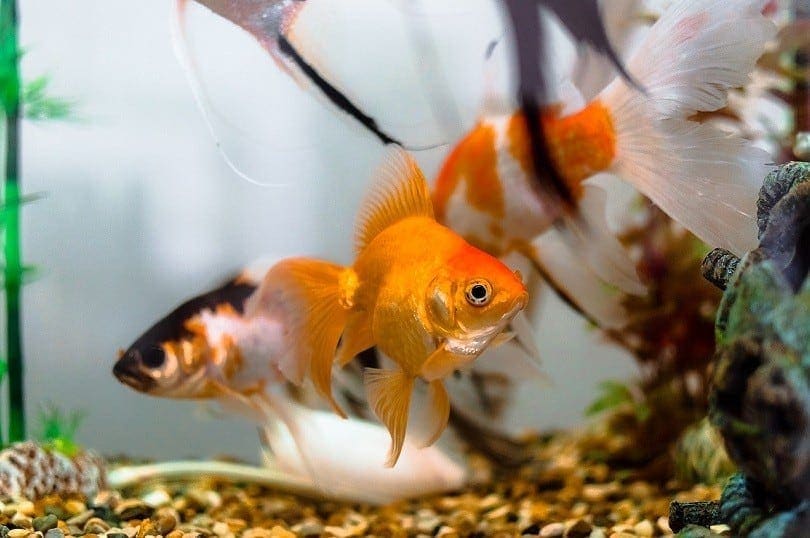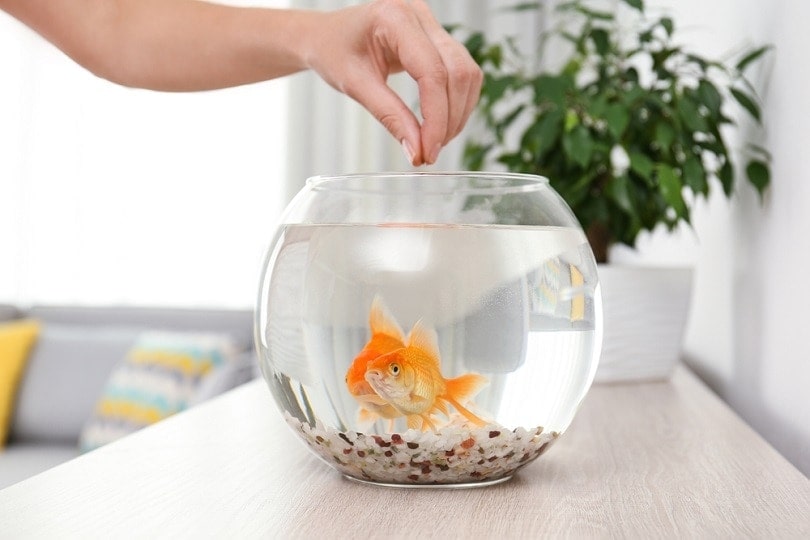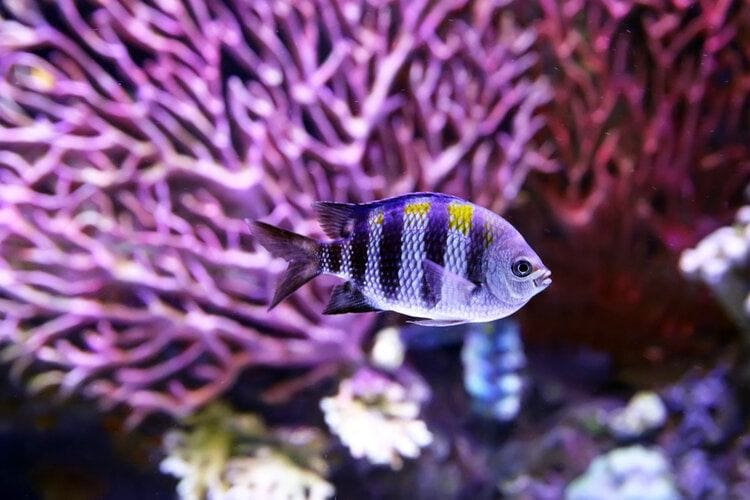Neon Tetras: Care Guide, Varieties, Lifespan & More (Vet-Approved Info)

Updated on
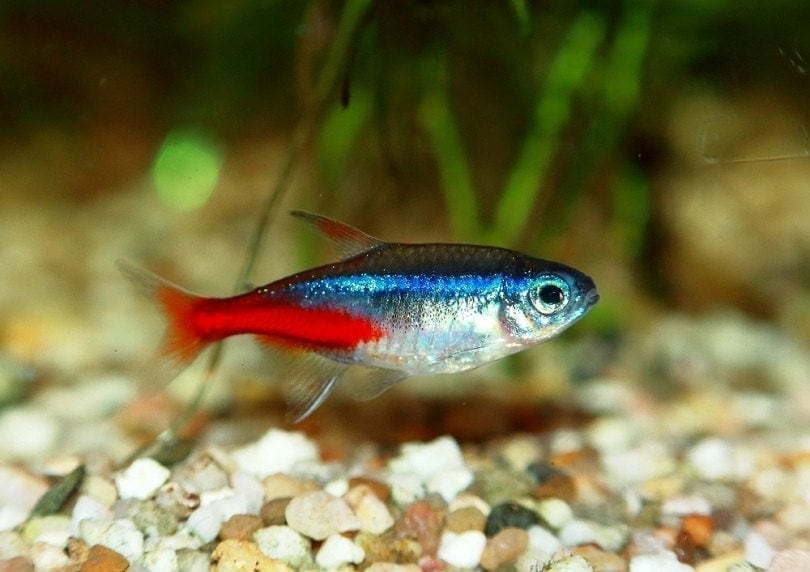
One of the most common fish you see in pet stores and home aquariums is the Neon Tetra. They’re a popular fish, and for good reason! Neon tetras are brightly-colored shoaling fish, so they’re best kept in groups. They’re cute and fun to watch as they swim around, exploring their environment. But neon tetras do have specific needs and as popular as they are with beginners, many people take them home without understanding these needs and then end up with a tank full of heartbreak. Here are the things you need to know about caring for neon tetras.
Quick Facts About Neon Tetras
| Species Name: | Paracheirodon innesi |
| Family: | Characidae |
| Care Level: | Easy |
| Temperature: | 68–82 °F (20–28 °C) |
| Temperament: | Timid and peaceful |
| Color Form: | Silvery bodies with a horizontal blue stripe down the front end of the body and red stripe down the back end of the body |
| Lifespan: | 5 years (average) |
| Size: | 1-1.5 inches |
| Diet: | Omnivorous |
| Minimum Tank Size: | 10 gallons for a shoal of six |
| Tank Set-Up: | Blackwater with lots of plants |
| Compatibility: | Other peaceful tropical fish and invertebrates |
Neon Tetras Overview
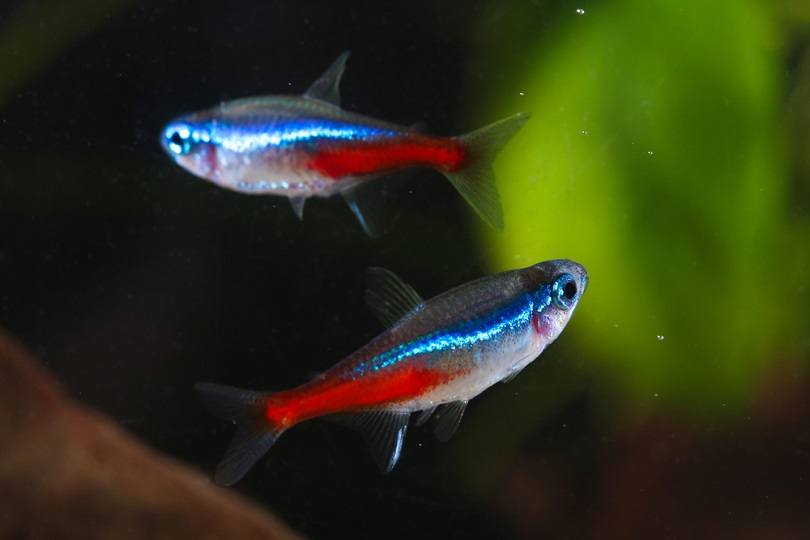
Neon tetras are the brightly-colored fish you often see zipping around aquariums in large groups. This is because they’re shoaling fish, which means they stay in groups of their own kind for social purposes. You may also see them referred to as schooling fish, but schooling is technically the action of the fish all swimming the same direction together, often in response to a stimulus like a perceived threat.
Since they are shoaling fish, neon tetras are happiest in groups of six or more. Six is the absolute minimum number of fish to keep together to provide a sense of safety and security. In groups this small, they may be more easily frightened and stressed. Groups of 15 or more are ideal and will encourage the most active, social behavior in the fish.
An interesting fact about neon tetras is that they prefer to be kept in blackwater environments. This does not mean dirty water, but it refers to water that is high in tannins from driftwood, peat, and leaf litter. This type of water is acidic and is usually slow-moving. Blackwater environments are the Neon Tetra’s natural environment in the wild.
How Much Do Neon Tetras Cost?
Neon tetras range in cost from about $1 to $3, so they are inexpensive fish. Even purchasing a whole group of them shouldn’t set you back too much. The main expense associated with neon tetras is the tank and tank accessories. Indian almond leaves, which help acidify the water and create leaf litter, are usually around $10 for a few leaves. Driftwood can range from inexpensive to very expensive depending on the wood and the cut, and plants to create a healthy planted tank can also add up. Assuming you already have the tank, expect to spend $50 to $100 to get a tank set up and purchase the fish.
Typical Behavior & Temperament
Neon tetras are peaceful fish, but they are also very timid, especially when kept in small groups. In small groups, they will likely spend a lot of time hiding out in tall plants or in the roots of floating plants, only making appearances when they feel completely safe. In larger groups, they may be more out and about in the tank, especially if they don’t share a tank with larger fish that chase or nip them.
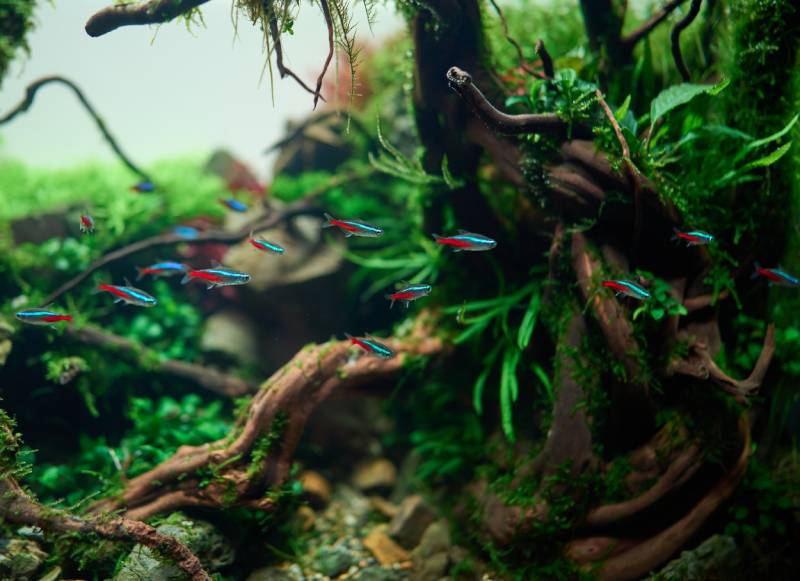
Appearance & Varieties
Neon tetras are noticeable fish, despite their small size. They are easily confused with another variety of Tetra, the Cardinal Tetra, but there is one subtle difference between them. Neon tetras have a bright blue stripe that runs almost down the full length of their body, usually along or near their lateral line. They also have a bright red stripe that runs part of the length of their body, starting mid-body or further back and running the rest of the length.
Cardinal Tetras have a similar body shape and silvery coloration with a bright blue stripe running down the entire length of their body and they have a bright red stripe that lies parallel to the blue stripe, sitting below it and running the full length of the body. Neon tetras are smaller than Cardinal Tetras as well, with Cardinal Tetras reaching up to 2 inches in length on average.
How to Take Care of Neon Tetras
Habitat, Tank Conditions & Setup
Tank/Aquarium Size
Due to their small size, neon tetras can be kept in a tank as small as 10 gallons, even with a small shoal of fish. If you are keeping more than 10 to 15 neon tetras, it’s a good idea to start sizing up the tank, especially if it’s a community tank.
Water Temperature & pH
Neon tetras are tropical fish from blackwater environments, so they prefer warm, acidic water. Their preferred temperature range is 68 to 82 °F (20 to 28 °C). Their preferred pH range is 5.5 and 7.5. The key aspect about temperature and pH is to keep it consistent within an acceptable range for your fish. Constantly fluctuating pH and temperature can be stressful for fish.
Please keep in mind that temperature in particular can very quickly fluctuate in smaller aquariums. If your fish are in a small aquarium, you should consider this and take appropriate precautions to ensure that it doesn’t happen.
Substrate
Neon tetras spend most of their time near the middle and lower portions of their tanks, but the substrate you use for them is not important. Some substrates can help lower pH, which may be something to consider if you’re looking for a specific aquatic setup for your aquarium.
Plants
Neon tetras love plants! Short plants and carpet plants will have little effect on them, but plants that reach the middle and upper portions of the water column will provide shelter and enrichment. Floating plants with long root systems can also provide shelter from above. Ludwigia, Cabomba, and Vallisneria are all good tall plants while red root floaters and Amazon frogbit can provide long, trailing root systems.
Lighting
Neon tetras prefer low lighting and their fry are extremely sensitive to light. You can use low-level lighting or floating plants to dim the light that reaches the tank, but this will also prevent lower plants from receiving lighting. Therefore, if you have plants in your aquarium, it’s best to cater the lighting to your plants’ needs.
Filtration
Neon tetras produce very little bioload, so a sponge filter should be adequate. If the tank is a community tank, you may need a HOB or internal filter, but you will need to make sure it’s safe for small fish and fry. They do not require a larger amount of water movement within the tank.
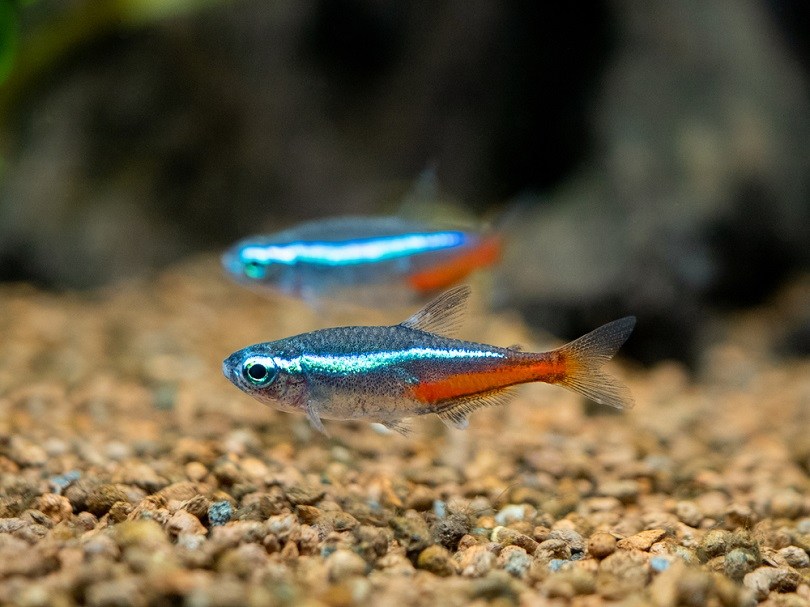
Are Neon Tetras Good Tank Mates?
While neon tetras make good tank mates, there are lots of fish that aren’t good tank mates for neon tetras. When kept with other small fish, shoaling fish, or fish that spend most of their time in a different part of the water column, like bottom feeders, they will be happy. They should not be kept in tanks with fish that are large enough to eat them or fish that are prone to fin nipping or chasing. They should also be kept with other fish that have similar water parameter needs to them.
Rasboras, danios, and most other types of tetras all make good tank mates for neon tetras. Some other types of Tetras with similar tank needs are aggressive and carnivorous, so make sure to read up on any fish you intend to keep in the tank with your neon tetras.
What to Feed Your Neon Tetras
Neon tetras are omnivorous, so they will eat both plant and animal matter. Their mouths are very small, so they should be fed a high-quality micro pellet or flake food. They should also be offered small invertebrates, like baby brine shrimp and copepods, and thawed frozen foods like small bloodworms.
Even with small foods and micro pellets, you may need to make the food even smaller by grinding or crushing. If your neon tetras seem to have any difficulty eating the food they’re offered, then try to make it smaller and see if that helps them. When they are large enough, neon tetras may attempt to predate shrimplets, so you’ll need to monitor this if they share a tank with shrimp.
Keeping Your Neon Tetras Healthy
The best way to keep your Neon Tetras healthy is to provide a healthy, low-stress tank environment for them. They should be provided with both adequate swimming space and plenty of hiding places among plants to feel safe. They also should not be kept in groups that are too small as this can lead to unnecessary stress on the fish. If you experience loss of neon tetras, make sure to verify the water parameters are within safe ranges for their needs. If they die from old age or injury, it’s a good idea to replace them when the group starts to get too small.
Breeding
Breeding neon tetras can be difficult starting out because of the difficulty level of maintaining the necessary water parameters. Once you get the hang of it, it can be much easier. Generally speaking, breeding isn’t advised unless you’re fully committed to the process (including caring for hundreds of fry).
For best results, the breeding pair should be placed into a tank specifically set up for spawning. This tank should be blackwater with plenty of tannins from leaf litter. The pH should be around 5.0 to 6.0 and the temperature should be in the high 70˚F range, somewhere around 78˚F is ideal. A spawning mop, like moss or carpeting plants, should be in place to catch the eggs. The breeding pair should be expected to stay in this tank for upwards of a week so they feel safe and ready to breed. Once spawning has occurred a few times, they can be moved back to the main tank.
The tank should be kept dark with tannins and low lighting during spawning and once the fry hatch, as they are extremely sensitive to light and too much light can kill them. The eggs will hatch within a few days of spawning and the babies will be able to eat things like infusoria and baby brine shrimp.
Are Neon Tetras Suitable For Your Aquarium?
Neon tetras are a great beginner fish, especially for the beginner who wants to jump into things with a group of fish instead of one or two. The fish’s needs should be top priority, though, so avoid making impulsive purchases of fish without understanding what their needs are and how to meet them.
Neon tetras are a beautiful accent or centerpiece in tanks and watching their coordinated shoaling is a sight to behold. Neon tetras are not as exotic as some of the newer fish entering the aquatics market, but they are tried and true, making them a great addition to your blackwater or acidic tank.
Check out some of our other tank life species care guides:
- Rainbow Shark: Care Guide, Varieties, Lifespan & More (with Pictures)
- Ember Tetra: Care Guide, Varieties, Lifespan & Traits (with Pictures)
- Bala Shark: Care Guide, Varieties, Lifespan & More (with Pictures)
Featured Image Credit: Kristiana Berzina, Shutterstock






